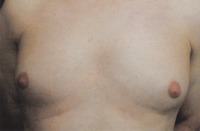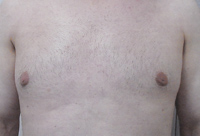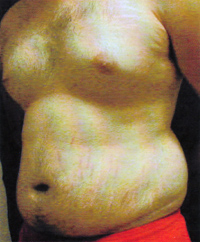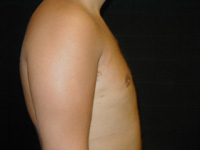![]()
Dr. Mirabadi was personally trained by the inventor of the Tumescent Liposuction Technique, a procedure that has been featured on ABC's 20/20 and is considered much safe than conventional liposuction. For more information about the procedure, please read below.
818-782-0004
Liposuction for Gynecomastia (enlarged male breasts) |
||||||||
|
||||||||

Before |

Next Day |
|
Male Br east & Abdominal Liposuction |
||
 Before |
 1 Month Later |
|
Photos above are of actual patients. Results may vary.
Please call us for a consultation to discuss your personalized needs.
Gynecomastia Symptoms and Treatment Options
Gynecomastia is a condition which causes abnormally large breasts on men. Sometimes experienced in babies due to female hormones from the mother, the condition is fairly common in adolescent boys. Most cases in young boys clear up without treatment up to 90% of the time within a period o f months or a couple of years. However, 10% of men who experience gynecomastia experience it as an ongoing condition.
Gynecomastia is not a physically harmful condition however in some cases it can indicate a more serious underlying condition. Puberty is only one reason for the onset of gynecomastia. Other reasons include steroid abuse, obesity, tumors, genetic disorders, and liver disease. Gynecomastia can also be experienced as a side effect of many types of prescription medications, or as a symptom of Klinefelter or Gilbert's Syndromes.
Manifestation of gynecomastia can occur in many ways. Puffiness in the nipple area is one of the most common forms of this condition. Puffiness often occurs when the tissue growth is mainly limited to the areola.
Glandular gynecomastia sometimes occurs in bodybuilders as a result of the use of steroids. Adolescent gynecomastia is often genetic or congenital, and typically appears between the ages of 9 and 14. About 30% to 60% of young boys suffer from this condition, and as many as 30% may carry the condition into adulthood.
Treatment Options
Fortunately, gynecomastia is a treatable condition. In cases of obesity, weight loss may alter the condition, but in many cases it will not completely eliminate it. In all other cases, surgery is the only known physical remedy. For many men, this is a great solution and accomplishes the first step in the healing process.
It is important for anyone suffering gynecomastia to talk to their doctor about finding the underlying cause of the condition. In some cases, treating that condition can lead to improvement in the appearance of large breasts. Patients should discuss medications with their doctors to see if an alternative medication can be found for their other condition.
Choosing a Doctor
When choosing a doctor to perform surgery for gynecomastia, it is important to feel comfortable. Ask to see before and after photos of previous patients. In some cases, the doctor may even have referrals of previous patients that are willing to speak about their experience.
Make sure to check with your insurance company before your consultation. Unfortunately, many insurance companies do not cover the surgery. When talking to your insurance company regarding the procedure, it is very important to let them know that this is a congenital condition and what types of symptoms you experience, such as breast tenderness.
Most doctors prefer to wait until a patient has completely finished puberty to perform any surgery for gynecomastia, usually between the ages of 18 to 20 years old. This assures that they do not prematurely treat patients for whom the condition will clear up without treatment.
Surgery for gynecomastia
Surgery to correct gynecomastia usually takes 45 minutes to 2 hours, and patients are able to go home the same day in most cases. The procedure is done under light I.V. sedation and local anesthesia. During the surgery, the doctor will remove glandular tissue using a small incision just below the areola. In most cases, the surgeon will also perform liposuction to shape the chest.
Recovery
There will be scarring, but for most patients the scars fade almost to invisibility within 6 months. The initial recovery period after surgery is between 5 and 7 days. Most patients can go back to work after 48 hours and total recovery time varies between 3 and 6 months.
Once the surgery is complete, it is important to address the psychological issues that often accompany this condition. Many men who suffer from gynecomastia experience psychological symptoms in addition to the physical manifestation of the condition. Boys and men with gynecomastia often struggle with anxiety regarding simple things like removing a shirt at the beach or in a locker room. Feelings of embarrassment, humiliation, and shame are also common.
Gynecomastia is a serious condition, but options are available for treatment. Help is available, and understanding the condition is the first step to recovery.
Contact us to schedule a free consultation and to view more photos of gynecomastia procedures. Dr. Mirabadi is happy to answer your questions in your free, private, twenty minute consultation session. During the consultation, you will have the opportunity to view many more before and after photos. Call us now at 818-782-0004
|
View more Before and after pictures: Plea se click here for our full procedures list Please click here for Dr. Mirabadi's bio |
| Offices in Beverly Hills & Los Angeles, C alifornia |
818-782-0004 |
| ©
1998 - 2023 Dr. Mirabadi. All rights reserved. |

